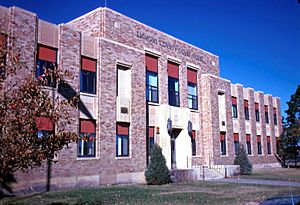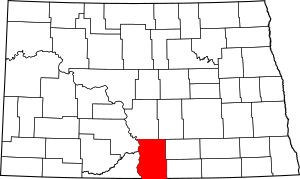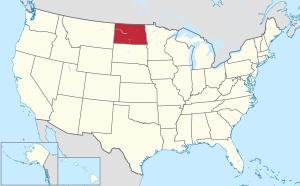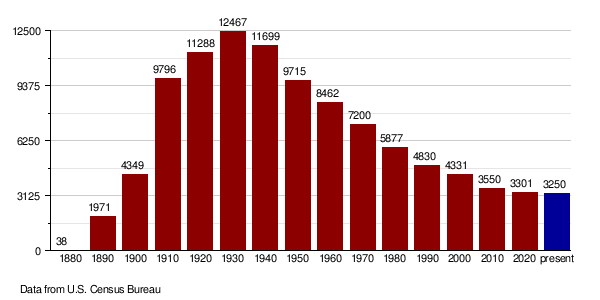Emmons County, North Dakota facts for kids
Quick facts for kids
Emmons County
|
|
|---|---|

Emmons County Courthouse in Linton
|
|

Location within the U.S. state of North Dakota
|
|
 North Dakota's location within the U.S. |
|
| Country | |
| State | |
| Founded | February 10, 1879 (created) November 9, 1883 (organized) |
| Seat | Linton |
| Largest city | Linton |
| Area | |
| • Total | 1,555 sq mi (4,030 km2) |
| • Land | 1,510 sq mi (3,900 km2) |
| • Water | 45 sq mi (120 km2) 2.9% |
| Population
(2020)
|
|
| • Total | 3,301 |
| • Estimate
(2022)
|
3,250 |
| • Density | 2.1228/sq mi (0.8196/km2) |
| Time zone | UTC−6 (Central) |
| • Summer (DST) | UTC−5 (CDT) |
| Congressional district | At-large |
Emmons County is a place in North Dakota, a state in the United States. It's called a county. In 2020, about 3,301 people lived here. The main town, or county seat, is Linton. It has been the county seat since 1899.
Contents
History of Emmons County
How Emmons County Was Formed
Emmons County was created on February 10, 1879. This happened when the government of Dakota Territory decided to make new areas. They took land from Burleigh and Campbell counties.
At first, the county didn't have its own government. But on November 9, 1883, it became officially organized. The county was named after James A. Emmons. He was a steamboat operator and a businessman in Bismarck, North Dakota.
Early Settlers and Their Challenges
The first non-Native people to settle in Emmons County came from Europe and the eastern United States. Many were soldiers who had finished their service at Fort Yates. More civilians started arriving in the 1880s.
Two main groups of settlers came. One group was Germans, from both Russia and Germany. The other group was Hollanders, who came from the eastern U.S. The Hollanders lived only in the southwestern part of the county. The Germans settled all over the area.
Life was tough for these early settlers. The weather was very extreme. They faced cold winters with blizzards and hot summers with thunderstorms and tornadoes.
Homes of the Pioneers
Early settlers built simple homes using what they could find. The very first building in Emmons County was a log cabin. It was built near a place called Winona in 1852.
Some homes were made with tar paper or local rocks. But the most common type of home was the sod house. These houses were made from blocks of prairie grass and dirt. Sod was a great solution because there wasn't much wood available. As time passed and building materials became easier to get, people built more modern homes.
Travel and Transportation
Getting around was another big challenge. There were no roads, and the closest railroad was 40 miles (64 km) away in Eureka, South Dakota. People usually traveled by horse and wagon. They even used piles of buffalo bones as landmarks to find their way across the wide-open prairie.
Crossing creeks and streams was hard because there were no bridges. Settlers often traveled in pairs. They would use both teams of horses to pull each wagon across the water. The first bridge in Emmons County was built in 1889.
The Missouri River forms the western edge of the county. Some settlers made money by selling wood to steamboats in the summer. Ferries helped people and goods cross the river. Barges were used to move goods along the river itself.
Growth of Towns
The first town in the county that still exists today is Braddock. It was started in 1898. A railroad line reached Braddock in the same year.
Linton was planned in 1899. It was placed near the center of the county to be the new county seat. By 1901, Linton had 118 residents, and by 1903, it had 245.
Another town, Tirsbol, was started in 1902. It was about 10 miles (16 km) south of Linton. This town became a center for German immigrants and was later renamed Strasburg. In 1902, Hague was also established southeast of Strasburg. And Hazelton was planned near Williamsport.
Towns That Disappeared
Winona was the very first settlement in the county, started in 1874. It was first called 'Devils Colony'. It served soldiers and early settlers. In the 1880s, it was the largest town between Bismarck, North Dakota and Pierre, South Dakota. The county's first school was built there in 1884. The first newspaper was published there in 1885. But when Linton was created, Winona slowly faded away and was gone by the early 1900s.
Williamsport was established in 1883 and was the first county seat. But like Winona, it lost people to Linton and Hazelton and was abandoned in 1903.
Other towns that no longer exist include Emmonsburg, Glencoe, Winchester, and Westfield. Godkin was started in 1902 and later renamed Temvik. It grew to over 200 people by 1925. But the Great Depression in the 1930s and being bypassed by U.S. Highway 83 led to its decline. Its post office closed in 1968. Kintyre, settled by Swedes and Norwegians, was established in 1908 but was also later abandoned.
Geography of Emmons County
Emmons County is located on the southern border of North Dakota. Its southern edge touches the state of South Dakota. The Missouri River flows along the county's western border, heading south.
The land in the county has gentle, rolling hills. Most of the land is used for farming. The county's total area is about 1,555 square miles (4,027 km²). Of this, 1,510 square miles (3,911 km²) is land, and 45 square miles (117 km²) is water.
Main Roads
 US 83
US 83 ND 11
ND 11 ND 13
ND 13 ND 34
ND 34 ND 1804
ND 1804
Neighboring Counties
- Burleigh County - north
- Kidder County - northeast
- Logan County - east
- McIntosh County - southeast
- Campbell County, South Dakota - south
- Corson County, South Dakota - southwest
- Sioux County - west
- Morton County - northwest
Protected Natural Areas
These are special places in Emmons County that are protected for nature and wildlife:
- Appert Lake National Wildlife Refuge
- Beaver Creek Recreation Area
- Flickertail National Wildlife Management Area
- North Dakota Fisheries Management Area
- Springwater National Wildlife Refuge
- Sunburst Lake National Wildlife Refuge
Lakes in Emmons County
Here are some of the lakes found in the county:
- Appert Lake
- Braddock Dam
- Goose Lake
- Lake Oahe (part)
- Neuwama Lake
- Rice Lake
- Stink Lake
- Sunburst Lake
- Schwahn Lake
Population and People
| Historical population | |||
|---|---|---|---|
| Census | Pop. | %± | |
| 1880 | 38 | — | |
| 1890 | 1,971 | 5,086.8% | |
| 1900 | 4,349 | 120.6% | |
| 1910 | 9,796 | 125.2% | |
| 1920 | 11,288 | 15.2% | |
| 1930 | 12,467 | 10.4% | |
| 1940 | 11,699 | −6.2% | |
| 1950 | 9,715 | −17.0% | |
| 1960 | 8,462 | −12.9% | |
| 1970 | 7,200 | −14.9% | |
| 1980 | 5,877 | −18.4% | |
| 1990 | 4,830 | −17.8% | |
| 2000 | 4,331 | −10.3% | |
| 2010 | 3,550 | −18.0% | |
| 2020 | 3,301 | −7.0% | |
| 2022 (est.) | 3,250 | −8.5% | |
| U.S. Decennial Census 1790-1960 1900-1990 1990-2000 2010-2020 |
|||
Population in 2020
According to the census in 2020, there were 3,301 people living in Emmons County.
Population in 2010
In the census of 2010, there were 3,550 people. Most people in the county were white (98.5%). About 1% of the population was of Hispanic or Latino background. Many residents have German (69.1%), Russian (16.8%), or Norwegian (12.3%) family backgrounds.
How the Population Has Changed Over Time
The chart below shows how the number of people living in Emmons County has changed over many years. You can see how the population grew and then slowly decreased.

Communities in Emmons County
Cities You Can Visit
Other Communities (Unincorporated)
These places are smaller communities that are not officially organized as cities:
Townships
- Campbell
Townships That No Longer Exist
- Buchanan Valley
- Hazelton
- Lincoln
- McCulley
- Tell
Images for kids
See also
 In Spanish: Condado de Emmons para niños
In Spanish: Condado de Emmons para niños


